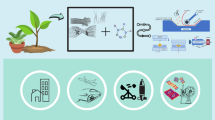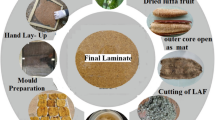Abstract
Replacing glass fiber reinforced composites is the current challenge for flax fiber reinforced composites to reduce cost and weight of structural components. However, the quality of the machined flax fibers must be comparable to that of glass fiber. Machining a composite material means before every other consideration cutting the fibers of this material and therefore entails a risk of damage in the vicinity of the machined zone. The aim of this paper is therefore to compare experimentally the machining quality of the flax fiber reinforced polymers composite (FFRP) with that of the glass fiber reinforced polymers composite (GFRP) based on the Split-Split Plot randomized complete block design. Thus, two cutting tools were tested and the most suitable tool for each material was selected. Based on the experimental results, it was observed that the type of the cutting tool has a significant effect on the delamination behavior. Furthermore, results show that flax fiber composites can be easily machined, hence no tool wear was observed. Results also show that a two-flute uncoated carbide end mill tool is more suitable for trimming flax fiber composite while a two-flute polycrystalline Diamond end mill (PCD) tool is better suited for trimming GFRP. The lowest delamination (uncut fiber) was observed at 0º and 45º ply orientation for both materials.

























Similar content being viewed by others
References
Yan L, Chouw N, Jayaraman K (2014) Flax fibre and its composites – A review. Compos Part B 56:296–317
Baley C, Gomina M, Breard J et al (2019) Specific features of flax fibres used to manufacture composite materials. Int J Mater Form 12:1023–1052. https://doi.org/10.1007/s12289-018-1455-
Derbali I, Terekhina S, Guillaumat L et al (2019) Rapid manufacturing of woven comingled flax/polypropylene composite structures. Int J Mater Form 12:927–942
Staiger M, Tucke N (2008) Natural fibre composites in structural applications. In: Properties and Performance of Natural-Fibre Composites, Woodhead Publishing Series in Composites Science Engineering, 269–300. https://doi.org/10.1533/9781845694593.2.269
Shahinur S, Hasan M (2019) Natural fiber and synthetic fiber composites: comparison of properties, performance, cost and environmental benefits. In: Reference module in materials science and materials engineering. Elsevier, Amsterdam. ISBN 9780128035818. https://doi.org/10.1016/B978-0-12-803581-8.10994
Darshil U, Shah, Peter J, Schubel, Mike J, Clifford (2013) Can flax replace E-glass in structural composites? A small wind turbine blade case study. Compos B 52:172–181
Tarrés Q, Oliver-Ortega H, Espinach FX, Mutjé P, Delgado-Aguilar M, Méndez JA (2019) Determination of mean intrinsic flexural strength and coupling factor of natural fiber reinforcement in polylactic acid biocomposites. Polymers 11(11):1736. https://doi.org/10.3390/polym11111736
Velde KV, Kiekens P (2001) Thermoplastic pultrusion of natural fiber reinforced composites. Compos Struct 54:355–360
Pickering KL, Efendy MGA, Le TM (2016) A review of recent developments in natural fibre composites and their mechanical performance. Compos Part A: Appl Sci Manufac 83:98–112
Davies GC, Bruce DM (1998) Effect of environmental relative humidity and damage on the tensile properties of flax and nettle fibers. Text Res J 68(9):623–629
van Voorn B, Smit HHG, Sinke RJ, De Klerk B (2001) Natural fibre reinforced sheet moulding compound. Compos: Part A 32:1271–1279
Placet V, Cisse O, Boubakar ML (2012) Influence of environmental relative humidity on the tensile and rotational behaviour of hemp fibres. J Mater Sci 47:3435–3446
Khalid MY, Arif ZU, Sheikh MF, Nasir MA (2021) Mechanical characterization of glass and jute fiber-based hybrid composites fabricated through compression molding technique. Int J Mater Form. https://doi.org/10.1007/s12289-021-01624-w
Dhakal HN, Zhang ZY, Guthrie R, Macmullen J, Bennett N (2013) Development of flax / carbon fibre hybrid composites for enhanced properties. Carbohydr Polym 96(1):1–8
Nunna S, Chandra PR, Shrivastava S (2012) A review on mechanical behavior of natural fiber based hybrid composites. J Reinf Plast Compos 31(11):759–769
Zhang Y, Li Y, Ma H, Yu T (2013) Tensile and interfacial properties of unidirectional flax / glass fiber reinforced hybrid composites. Compos Sci Technol 88:172–177
Jawaid M, Khalil HPSA (2015) Cellulosic / synthetic fibre reinforced polymer hybrid composites: A review. Carbohydr Polym 86(1):1–18
Asim Shahzad (2019) Investigation into fatigue strength of natural/syntheticfiber-based composite materials. In: Mechanical and Physical Testing of Biocomposites, Fibre-Reinforced Composites and Hybrid Composites. Woodhead Publishing Series in Composites Science and Engineering
Beardmore P, Johnson CF (1986) The potential for composites in structural automotive applications. Compos Sci Technol 26:251–281
Arif M, Asif M, Ahmed I (2017) Advanced composite material for aerospace application-a review. Int J Eng Manuf Sci 7(2):393–409
Hyer MW (2009) Stress analysis of fiber-reinforced composite materials. DEStech Publications, Inc., Lancaster
Caggiano A. Machining of fibre reinforced plastic composite materials. Materials (Basel, Switzerland) 11(3):442. https://doi.org/10.3390/ma11030442
Sorrentino L, Turchetta S, Colella L, Bellini C (2016) Analysis of thermal damage in FRP drilling. Procedia Eng 167:206–215
Sheikh-Ahmad JY, Almaskari F, Hafeez F (2019) Thermal aspects in machining CFRPs: effect of cutter type and cutting parameters. Int J Adv Manuf Technol 100:2569–2582
Yashiro T, Ogawa T, Sasahara H (2013) Temperature measurement of cutting tool and machined surface layer in milling of CFRP. Int J Mach Tools Manuf 70:63–69
Xu W, Zhang L (2019) Heat effect on the material removal in the machining of fibre-reinforced polymer composites. Int J Mach Tools Manuf 140:1–11
Shen Z, Lu L, Sun J, Yang F, Tang Y, Xie Y (2015) Wear patterns and wear mechanisms of cutting tools used during the manufacturing of chopped carbon fiber. Int J Mach Tool Manufact 97:1–10
Wang H, Yang L, Wu H (2020) Study on mechanical and thermomechanical properties of flax/glass fiber hybrid-reinforced epoxy composites. Polym Compos :1–10. https://doi.org/10.1002/pc.25860
Chu L, Shi J, Yu H, de Cursi ES (2019) Uncertainty propagation in moisture absorption of flax/glass fiber reinforced hybrid composites. Mater Res Express 6:115208
Liang S, Gning PB, Guillaumat L (2012) A comparative study of fatigue behaviour of flax/epoxy and glass/epoxy composites. Compos Sci Technol 72:535–543
Khandai S, Nayak RK, Kumar A, Das D, Kumar R (2019) Assessment of mechanical and tribological properties of Flax/Kenaf/Glass/Carbon fiber reinforced polymer composites. Mater Today Proc 18:3835–3841
Karatas MA, Gokkaya H (2018) A review on machinability of carbon fiber reinforced polymer (CFRP) and glass fiber reinforced polymer (GFRP) composite materials. Def Technol 14:318–326
Trushin NN, Lisitsin VN (2018) Experimental study of fiber-glass plastic work pieces contour milling. IOP Conf Ser Mater Sci Eng 327:042110. https://doi.org/10.1088/1757-899X/327/4/042110
Prakash C, Sekar V (2018) 3D finite element analysis of slot milling of unidirectional glass fiber reinforced polymer composites. J Braz Soc Mech Sci Eng 40:279
Jenarthanan MP, Gujjalapudi VSS, Venkatraman V (2017)Multi-objective optimization in end-milling of glass fiber reinforced polymer composites using desirability functional analysis and grey relational analysis. Multidiscip Model Mater Struct 13(3):391–408. https://doi.org/10.1108/MMMS-11-2016-0059
Çelik YH, Alp MS (2020) Determination of milling performance of jute and flax fiber reinforced composites. J Nat Fibers. https://doi.org/10.1080/15440478.2020.1764435
Chegdani F, Takabi B, El Mansori M, Taib BL, Bukkapatnam STS (2020) Effect of flax fiber orientation on machining behavior and surface finish of natural fiber reinforced polymer composites. J Manuf Process 54:337–346
Zhang H, Liu D, Huang T, Hu Q, Lammer H (2020)Three-dimensional printing of continuous flax fiber-reinforced thermoplastic composites by five-axis machine. Materials 13:1678. https://doi.org/10.3390/ma13071678
Rezghi Maleki H, Hamedi M, Kubouchi M, Arao Y (2019) Experimental investigation on drilling of natural flax fiber-reinforced composites. Mater Manuf Processes 34(3):283–292. https://doi.org/10.1080/10426914.2018.1532584
Wang F, Yin J, Jia Z, Niu B, Liu W (2018) A novel approach to evaluate the delamination extent after edge trimming of carbon-fiber-reinforced composites. Proc IMechE Part B J Eng Manuf 232(14):2523–2532. https://doi.org/10.1177/0954405417699015
Slamanî M, Chatelain J-F(2020) Kriging versus Bezier and regression methods for modeling and prediction of cutting force and surface roughness during high speed edge trimming of carbon fiber reinforced polymers. Measurement 152:107370
Slamani M, Chatelain J-F, Hamedanianpour H (2019), Influence of machining parameters on surface quality during high speed edge trimming of carbon fiber reinforced polymers. Int J Mater Form 12:331–353
Slamani M, Gauthier S, Chatelain, J-F(2015) A study of the combined effects of machining parameters on cutting force components during high speed robotic trimming of CFRPs. Measurement 59:268–283
Funding
This work was funded by the Natural Sciences and Engineering Research Council of Canada (grant # RGPIN-2017-04305).
Author information
Authors and Affiliations
Corresponding author
Ethics declarations
Conflicts of interest/Competing interests
The authors declare that they have no conflict of interest.
Additional information
Publisher’s Note
Springer Nature remains neutral with regard to jurisdictional claims in published maps and institutional affiliations.
Rights and permissions
About this article
Cite this article
Slamani, M., Karabibene, N., Chatelain, JF. et al. Edge trimming of flax fibers and glass fibers reinforced polymers composite – An experimental comparative evaluation. Int J Mater Form 14, 1497–1510 (2021). https://doi.org/10.1007/s12289-021-01644-6
Received:
Accepted:
Published:
Issue Date:
DOI: https://doi.org/10.1007/s12289-021-01644-6




